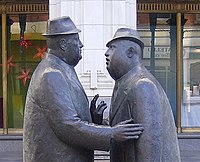
Photo from wikipedia
The COVID-19 pandemic has deeply influenced the tourism and hospitality industry, and it has also reshaped people’s travel preferences and related behaviors. As a result, how prospective travelers perceive travel… Click to show full abstract
The COVID-19 pandemic has deeply influenced the tourism and hospitality industry, and it has also reshaped people’s travel preferences and related behaviors. As a result, how prospective travelers perceive travel constraints and their effects on future travel behaviors may have changed to some extent. Besides, such perception arguably varies across gender. Therefore, this research examines the interplay between travel constraints, gender, and travel intentions for facilitating robust tourism recovery by revisiting the Leisure Constraints Model (LCM) from a gender perspective. Data were collected through a survey from 357 Malaysian prospective travelers. By conducting path analysis and multigroup analysis (MGA), it is found that structural and interpersonal constraints impose indirect effects on travel intentions (mediated by intrapersonal constraints), and gender moderating the effect of structural cost on intrapersonal constraints and effect of intrapersonal constraints on travel intentions. Based on these findings, this research provides theoretical and practical implications into how to adjust their marketing strategies and travel products during the era of “new normal” for tourism policy makers, destination marketers, and related businesses.
Journal Title: Frontiers in Psychology
Year Published: 2022
Link to full text (if available)
Share on Social Media: Sign Up to like & get
recommendations!